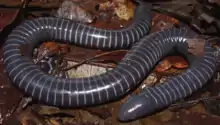Siphonops annulatus
Siphonops annulatus, the ringed caecilian, is a species of caecilian in the family Siphonopidae from South America.[2] It might have the broadest known distribution among terrestrial caecilian species.[3]
| Siphonops annulatus | |
|---|---|
 | |
| Scientific classification | |
| Kingdom: | Animalia |
| Phylum: | Chordata |
| Class: | Amphibia |
| Order: | Gymnophiona |
| Clade: | Apoda |
| Family: | Siphonopidae |
| Genus: | Siphonops |
| Species: | S. annulatus |
| Binomial name | |
| Siphonops annulatus (Mikan, 1820) | |
| Synonyms | |
|
Caecilia interrupta Cuvier, 1829 | |
Description
Ringed caecilian measures 286–450 mm (11.3–17.7 in) in total length. The body is cylindrical and slightly wider than deep. It is bluish-black to slate in colour. The annular grooves that completely encircle the body (except the 3–4 posteriormost ones) are edged in white or cream.[3]
A team of scientists from Brazil and the United States discovered that these organisms have oral venomous glands.[4][5]
Distribution and habitat
Widely distributed east of the Andes: originally discovered in Brazil,[2] reported to exist in Argentina, Bolivia, Colombia, Ecuador, French Guiana, Guyana, Paraguay, Peru, Suriname, and Venezuela. Its natural habitats are subtropical or tropical moist lowland forest, dry savanna, moist savanna, subtropical or tropical moist shrubland, subtropical or tropical seasonally wet or flooded lowland grassland, pastureland, plantations, rural gardens, and heavily degraded former forest.[1]
Reproduction
Nestlings are equipped with 44 spoon-shaped teeth to feed on the outer layer of their mother's skin. Young feed all at once for some seven minutes; then they all rest for three days as the female grows a new outer skin layer.[6] This phenomenon is known as maternal dermatophagy. This practice and morphological similarities are shared with its African relative Boulengerula taitana, suggesting it evolved over 100 million years ago.[7]
References
- Lavilla, E.; Hoogmoed, M.; Reichle, S.; Baldo, D.; Wilkinson, M. & Measey, J. (2010). "Siphonops annulatus". IUCN Red List of Threatened Species. 2010. Retrieved 6 July 2013.CS1 maint: ref=harv (link)
- Frost, Darrel R. (2015). "Siphonops annulatus (Mikan, 1820)". Amphibian Species of the World: an Online Reference. Version 6.0. American Museum of Natural History. Retrieved 13 April 2015.
- "Siphonops annulatus". AmphibiaWeb: Information on amphibian biology and conservation. [web application]. Berkeley, California: AmphibiaWeb. 2015. Retrieved 13 March 2015.
- "Scientists Discover New Species of Amphibians with Snake-Like Venom Glands". www.news18.com. Retrieved 2020-07-04.
- Jared, Carlos; Mailho-Fontana, Pedro Luiz; Marques-Porto, Rafael; Sciani, Juliana Mozer; Pimenta, Daniel Carvalho; Brodie, Edmund D.; Antoniazzi, Marta Maria (2018-02-23). "Skin gland concentrations adapted to different evolutionary pressures in the head and posterior regions of the caecilian Siphonops annulatus". Scientific Reports. 8 (1): 1–7. doi:10.1038/s41598-018-22005-5. ISSN 2045-2322.
- David Attenborough: Life in Cold Blood, page 28. BBC Books, 2008.
- Wilkinson, Mark; Kupfer, Alexander; Marques-Porto, Rafael; Jeffkins, Hilary; Antoniazzi, Marta M; Jared, Carlos (June 2008). "One hundred million years of skin feeding? Extended parental care in a Neotropical caecilian (Amphibia: Gymnophiona)". Biology Letters. 4 (4): 358–61. doi:10.1098/rsbl.2008.0217. PMC 2610157. PMID 18547909.
External links
 Data related to Siphonops annulatus at Wikispecies
Data related to Siphonops annulatus at Wikispecies Media related to Siphonops annulatus at Wikimedia Commons
Media related to Siphonops annulatus at Wikimedia Commons
